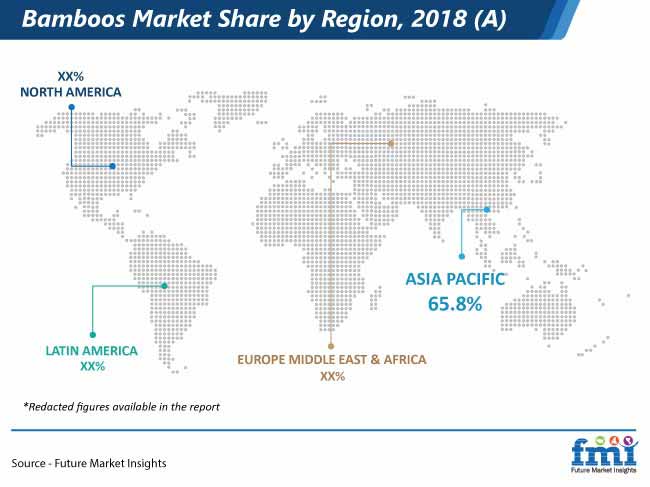Ascending demand from key end-use industries such as paper & pulp, building & construction, textile, and wood is projected to primarily drive demand for bamboos. The global bamboos market would progress at a high double-digit CAGR during 2019 – 2029, reaching a mark of US$ 12 Bn in 2029, as projected by a new Future Market Insights (FMI) study.
Bamboo is a versatile multi-purpose forest produce and plays a vital role in the world’s domestic and industrial economies. Bamboo and bamboo-based products are used for a wide range of indoor and outdoor applications, owing to its abundance and versatility.
Request a Sample of this Report @ https://www.futuremarketinsights.com/reports/sample/rep-gb-347
Key Takeaways – Bamboos Market Study
- The pulp & paper end-use industry segment in the global bamboos market is witnessing high growth, and is expected to follow the same trend over the forecast period owing to utilization of bamboo as a raw material in the production of paper & pulp.
- Bamboo produces about 35% more oxygen as compared to other trees. Additionally, its biomass is an efficient and cheap fuel for power generating units. As a result of this, the power sector is focusing on bamboos as a source of fuel for power generation.
- Asia Pacific (APAC) is expected to maintain its dominance in the global bamboos market throughout the forecast period in terms of volume as well as value. This can be mainly attributed to the growing construction industry in China and India, supported by surging infrastructural investments. APAC has more than half of the total bamboo species available in the world.
Thriving penetration of green building technologies is supporting the demand for bamboos due to utilization in construction of scaffolding. Moreover, there is a continuous demand for bamboo furniture, plywood, and outdoor decking in various countries.

Who Is Winning the Bamboos Landscape?
The global bamboos market is fairly fragmented, with small- and medium-scale enterprises accounting for major market share in the global market. Some of the key market players included in the report are Moso International B.V., Bamboo Village Company Limited, and Shanghai Tenbro Bamboo Textile Co. Ltd. New product launches and developments are some of the key strategies adopted by market players to retain their position in the global bamboos market. The companies are engaged in continuously participating in different events, conferences, tradeshows and seminars to market their newly launched products across the globe.
Ask An Analyst @ https://www.futuremarketinsights.com/ask-the-analyst/rep-gb-347
Bamboos Market – Regional Analysis
High growth in construction, pulp & paper, and furniture industries is expected to be a key driving factor for bamboos market growth. China is a large exporter of processed bamboo products such as bamboo plaiting, bamboo shoots, bamboo panels, wood charcoal of bamboo, etc., whereas countries such as the U.S., Canada, and other European countries where very small bamboo resources are available import bamboo products requirement from other bamboo-rich countries.
Asia Pacific (APAC) and Latin America will remain the goldmine of bamboos market growth over the next decade. China and Brazil are spearheading the regional markets respectively, with the former representing the most lucrative opportunities. While the bamboos market in India is flourishing on the back of plenty bamboo forest cover, Japan’s notable average bamboo yield is also driving significant attention of market players.
How Growth will Unfold
The pulp & paper industry has been the primary consumer of bamboos owing to their optical property, and excellent tear index. Apart from that, the high-strength quotient of bamboos compared to traditional materials such as concrete, and steel is boosting their prominence as green building material. Despite challenges pertaining to changing regulations in the forest sector, rising trend of bamboo-infused alcohol and tea in Latin American countries – Mexico and Brazil – are setting high hopes for bamboos market players.
How will the bamboos market be critical in the future?
The global bamboos market is estimated to grow at a significant rate owing to high growth in construction, pulp and paper, and furniture industries. However, governmental laws and regulations, along with the policies on ownership of resources and security, and lack of institutional mechanisms have made it difficult to unlock abundant sources of bamboos.
Will transportation costs affect the future trajectory of the bamboos market?
Yes, a key challenge with regard to the processing of bamboo is the cost of transportation. Transportation costs are relatively high because culms are hollow inside. For economic reasons, it is important to do at least the primary processing as close as possible to the bamboo plantation.
Which application area holds potential growth opportunities for market players?
Pulp and paper industry, in order to reduce dependency on wood, is expected to provide sustainable opportunities for bamboo/bamboo products in the global market. Pulp & paper industry is one of the most established industries in the world and manufacturers of pulp & paper are utilizing bamboos as a raw material for the production of paper & pulp.
What is the degree of competition in the bamboos market?
The bamboos market shows a competitive structure, with the presence of large number of regional and local market players. Small- and medium-scale enterprises such as Moso International B.V., Shanghai Tenbro Bamboo Textile Co. Ltd., and others account for major market share in the global bamboos market.
Which region will lead the global bamboo sales?
Asia Pacific remains in the forefront of the bamboos market, with significant market potential exists in the growing markets of China and India. China, with the maximum number of bamboo species in the world, is a large exporter of processed bamboo products. China has the maximum number of bamboo species in the World, followed by India and other countries.
Buy Complete Report @ https://www.futuremarketinsights.com/checkout/347
Contact Us:
Future Market Insights
Unit No: AU-01-H Gold Tower (AU), Plot No: JLT-PH1-I3A,
Jumeirah Lakes Towers, Dubai,
United Arab Emirates
For Sales Enquiries: sales@futuremarketinsights.com
For Media Enquiries: press@futuremarketinsights.com
Website: https://www.futuremarketinsights.com